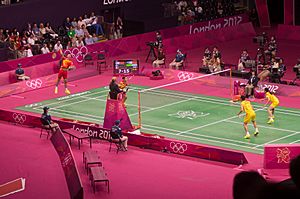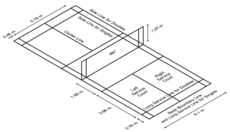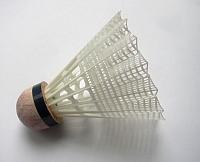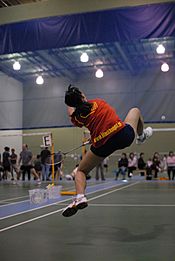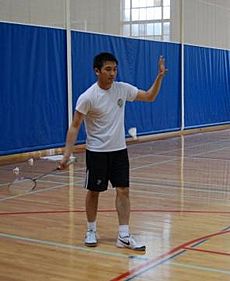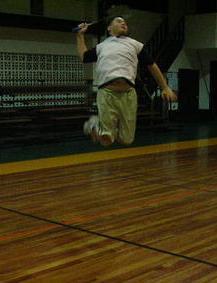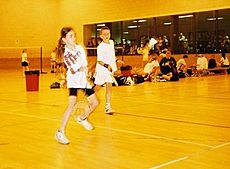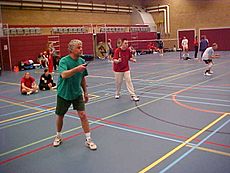Badminton facts for kids
Badminton is a fun sport where players use special rackets to hit a shuttlecock over a net. You might also hear the shuttlecock called a birdie. It's not like a regular ball! A shuttlecock has feathers (or plastic in casual games) that make it fly differently and slow down much faster than a ball.
Players serve the birdie by hitting it over the net. Each team can only hit the shuttlecock once before it crosses the net. The goal is to make the shuttlecock land on the ground on the other team's side of the court. When it lands, your team scores a point! The most common ways to play badminton are "singles" (one player per side) and "doubles" (two players per side).
Badminton became popular in British India from an older game called battledore and shuttlecock. It has been an Olympic sport since 1992. At the Olympics, there are five different badminton events: men's singles, women's singles, men's doubles, women's doubles, and mixed doubles.
Contents
History of Badminton
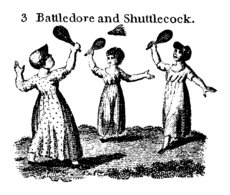

People have played games with shuttlecocks for hundreds of years across Europe and Asia. However, the modern game of badminton became popular in the mid-1800s among the British. They changed an older game called battledore and shuttlecock. "Battledore" was an old word for "racket."
No one knows exactly where badminton started. The sport got its name from the Duke of Beaufort's home, Badminton House, in Gloucestershire, England.
The game might have first developed among British officers living in British India. It was very popular there by the 1870s. The first rules were written in the town of Pune, India. By 1875, officers returning to England had started a badminton club in Folkestone. The rules changed a few times until 1893. That's when the Badminton Association of England (BAE) officially published the rules and started the sport.
More countries joined together to form the International Badminton Federation in 1934. These countries included England, Scotland, Wales, Canada, Denmark, France, Ireland, the Netherlands, and New Zealand. This group is now called the Badminton World Federation. Many more countries have joined since then, including India, China, Indonesia, Malaysia, and South Korea.
Badminton has also become a popular sport to play in backyards in the United States.
How to Play Badminton
This part explains the basic rules of badminton.
The Badminton Court
The badminton court is a rectangle with a net in the middle. Courts usually have lines for both singles and doubles games. The doubles court is wider than the singles court, but both are the same length. The serving line for doubles play is closer to the net.
The court is 44 feet (13.4 meters) long. It is 20 feet (6.1 meters) wide for doubles play. For singles play, the court is 17 feet (5.18 meters) wide. A line runs down the center of the court, dividing it in half. Servers must hit the shuttlecock diagonally across this center line and over the net to their opponent.
The net is 5 feet 1 inch (1.55 meters) high at the edges. It is slightly lower in the center, at 5 feet (1.524 meters). The net posts are placed at the doubles sideline, even when only one player per side is playing.
The rules don't say how high the ceiling above the court must be. However, players should try to play where the ceiling is high so they can hit the shuttlecock high without hitting the top.
Serving the Shuttlecock
When you serve, the shuttlecock must go over a special line called the short service line on your opponent's side. If it doesn't, it's a "fault," and you lose the point.
To start a rally (hitting the shuttlecock back and forth), the server and receiver stand in special areas called service courts. The server hits the shuttlecock so it lands in the receiver's service court. This is a bit like tennis, but with some key differences:
- In badminton, you must hit the serve from below your waist.
- The racket's shaft (the part between the head and handle) must point downwards.
- The shuttlecock is not allowed to bounce.
- Players must stand inside their service courts.
If the serving team loses a rally, the serve immediately goes to the other team. In singles, if your score is an even number (like 0, 2, 4), you serve from your right service court. If your score is an odd number (like 1, 3, 5), you serve from your left service court.
In doubles, if the serving team wins a rally, the same player serves again. But they switch service courts so they serve to a different opponent each time. If the other team wins the rally, and their new score is even, the player in the right service court serves. If their new score is odd, the player in the left service court serves.
Scoring Points
Each game in badminton is played to 21 points. Players score a point every time they win a rally, no matter which team served. A match is usually the best of three games. This means you need to win two games to win the whole match.
If the score reaches 20-all (meaning both teams have 20 points), the game continues. One team needs to get a two-point lead to win (for example, 24–22). However, if the score reaches 29-all, the next point is called a golden point. Whoever scores this point wins the game!
There are two ways to decide which team serves first in the first game:
- Shuttlecock toss: A shuttlecock is tossed, and the side it points to when it lands gets to serve first.
- Coin toss: A coin is flipped. One team calls "heads" or "tails." If they call it right, they win the toss and get to serve first.
In the games that follow, the team that won the previous game serves first. For the very first rally of any doubles game, the serving pair can choose who serves. The receiving pair can also choose who receives. Players switch ends of the court at the start of the second game. If the match goes to a third game, they switch ends at the start of the game and again when the leading team reaches 11 points.
The server and receiver must stay inside their service courts without touching the lines until the server hits the shuttlecock. The other two players can stand anywhere they want, as long as they don't block the view of the server or receiver.
What is a "Let"?
Sometimes, play is stopped, and no score is given. This is called a let. Lets happen when something unexpected happens during the game. For example, if another team's shuttlecock lands on your court, or if the shuttlecock touches the ceiling or a rail.
If the receiver isn't ready when the serve is hit, a let can be called. But if the receiver tries to hit the shuttlecock back, a let won't be called because they showed they were ready.
Badminton Equipment
Badminton rules control the size and shape of rackets and shuttlecocks.
Badminton Rackets
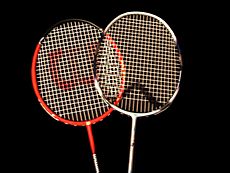
Badminton rackets are very light. Top-quality rackets weigh only about 2.5 to 3.4 ounces (70 to 95 grams). They are made from many different materials, like carbon fiber composite (a strong plastic with graphite) or even solid steel. In the past, rackets were made of aluminum or wood. Today, new materials like fullerene and carbon nanotubes are added to make rackets even stronger.
There are many different racket designs, but the rules limit their size and shape. The old oval head shape is still available, but a more common shape now is the "isometric" head, which looks a bit squarer.
Racket Strings
Badminton strings are thin, high-performance strings. They are usually between 0.62 and 0.73 millimeters thick. Thicker strings last longer, but many players like how thinner strings feel when they hit the shuttlecock. Professional players usually have higher string tension on their rackets than players who play just for fun.
Some people think higher string tension gives you more control, while lower tension gives you more power. Others believe the opposite! No one has proven either idea through testing. The best way for a player to find the right string tension is to try different ones.
Racket Grip
A grip is a material that looks like cloth tape. It's used to make the racket handle thicker and more comfortable to hold.
There are two main types of grip: replacement grips and overgrips. Replacement grips are thicker and can make the handle bigger. They have a sticky back, like a roll of tape. Many players use replacement grips without an overgrip.
Overgrips are thinner (less than 1 millimeter thick) and are often used as the top layer. They only have a small sticky part at the start of the tape. Overgrips are stretchy and stay on the handle because you wrap them tightly. They are good for players who change their grips often because of sweat or discomfort.
The Shuttlecock
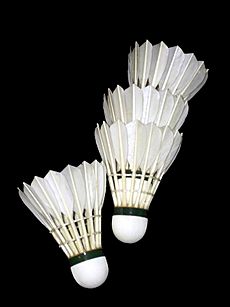
A shuttlecock (often called a shuttle or birdie) is a special object that flies with a lot of drag. It has an open cone shape. This cone is made from sixteen overlapping feathers stuck into a round cork base. The cork is covered with thin leather or a synthetic material. Some shuttlecocks are made of nylon with a plastic skirt. These nylon shuttles can have a natural cork or a foam base. Players who play for fun often use synthetic shuttles because feathered ones are expensive and break easily.
Badminton Shoes
Badminton shoes are light. Their soles are made of rubber or similar materials that grip well and don't leave marks.
Badminton involves a lot of sideways movement. Because of this, shoes with strong side support should not be used. They can make your ankles weaker, and the support might suddenly give out, causing sprains. Instead, badminton shoes should have a very thin sole and no side support. Good playing technique, proper footwork, and strong ankles are important to prevent injuries in badminton.
Badminton Technique
Hitting the Shuttlecock (Strokes)
All badminton shots can be hit either forehand or backhand. Your forehand side is the same side as your playing hand. So, for a right-handed player, the forehand side is their right side, and the backhand side is their left side. Forehand shots are hit with the palm of your hand facing the net. Backhand shots are hit with the back of your hand facing the net. Usually, forehand shots are more powerful. However, players don't always need to use a lot of power. Slower shots with good aim can also win a point. When you serve, the racket head must be lower than the racket handle when you hit the shuttlecock.
Where to Hit the Shuttlecock
The type of shot you choose depends on how close the shuttlecock is to the net, how high it is when you hit it, and where your opponent is on the court. If your opponent is close to the net, they are more likely to hit the shuttlecock with a hard overhead shot like a net kill, smash, or jump smash. Players can still hit overhead shots from the back of the court (the part furthest from the net). But they can't hit it downwards as much as they can from the front or middle of the court.
Shuttlecock Height and Shots
When the shuttlecock is well below the net, players have to hit it upwards. This shot is called a lift, and you can play it from anywhere on the court.
When the shuttlecock is near the net's height, players have two choices. They can hit drives, which send the shuttlecock straight and fast over the net. Drives are more powerful than pushes, which gently send the shuttlecock over the net.
Adding Spin to the Shuttlecock
Even though a shuttlecock doesn't bounce like a tennis ball, you can still slice it (hit it with an angled racket face) to change its direction and confuse your opponents. You can slice a shuttlecock from different sides to make it curve or slow down suddenly. If you slice a shuttlecock from underneath, it might tumble over itself a few times. This makes your opponent wait until the shuttlecock flies straight again before they hit it.
Because of how its feathers overlap, a shuttlecock naturally spins slightly counter-clockwise. This natural spin affects some shots.
How Your Body Helps (Biomechanics)
Scientists haven't studied badminton biomechanics (how your body moves in sports) as much as other sports. But some studies show how your wrist and arm rotations help create powerful shots.
The feathers on the shuttlecock create a lot of drag, making it slow down very quickly. If a player wants to hit the shuttlecock the full length of the court, they need to hit it very powerfully.
The shuttlecock is also very stable in the air. No matter how it's hit, it will always turn to fly cork-first and stay that way. If it's hit very high, the shuttlecock might even fall straight down.
Tricking Your Opponent (Deception)
Once players learn the basic shots, they can use other movements to trick their opponents. Slicing makes the shuttlecock move slower than your arm movement suggests. Some players can brush the strings around the shuttlecock as they hit it to make it spin.
Modern rackets are very light, which allows players to use very short hitting actions for many shots.
- Players can keep their arm fairly still and still hit a powerful shot.
- Players can also pretend they are going to hit a powerful shot. Then, if they see the opponent is ready for a strong hit, they can just flick their wrist lightly to send the shuttlecock gently.
- Players can use double motion. This is when they start moving the racket in one direction, stop that movement, and then hit in a different direction. Triple motion is possible but very rare.
- Players can use a racket head fake. This is when the initial racket movement continues, but the racket is turned during the hit. This makes the shuttlecock go in a different direction.
Badminton Strategy
To win in badminton, players need to use many different shots in the right situations. Tricking your opponents is also a very important strategy in badminton.
Singles Strategy
In singles, one person has to cover the whole court. So, a common strategy is to make your opponent move as much as possible. Players do this by placing their shots in different areas of the court. Smashing happens less often in singles than in doubles. This is because it's harder for one player to hit a shuttlecock that comes back quickly after a smash.
Doubles Strategy
In doubles, both pairs will try to attack and stay in an attacking position. They will smash downwards whenever they can. Sometimes, both players need to play in the middle of the court to defend against an attack from the other team. In doubles, players usually try to smash the shuttlecock between the two opponents to confuse them.
In high-level games, the backhand serve has become popular. The rallies (back-and-forth hitting) are extremely fast. Men's doubles is the most aggressive type of badminton. It has the most powerful jump smashes and very quick reflex changes. Because of this, men's doubles often has more fans than singles.
Mixed Doubles Strategy
In mixed doubles, both pairs usually try to keep an attacking formation. This means the woman plays at the front of the court, and the man plays at the back. This is because male players are usually stronger and can hit more powerful smashes. Smart opponents will try to change this ideal position by forcing the woman to the back or the man to the front. To avoid this, mixed doubles players must choose their shots carefully.
Badminton Organizations
Governing Bodies
The Badminton World Federation (BWF) is the main international group that controls the sport. They organize tournaments and make sure the game is played fairly. Five regional groups work with the BWF:
- Asia: Badminton Asia Confederation (BAC)
- Africa: Badminton Confederation of Africa (BCA)
- Americas: Badminton Pan Am (North America and South America are in the same group; BPA)
- Europe: Badminton Europe (BE)
- Oceania: Badminton Oceania (BO)
Badminton Competitions
The BWF organizes several international competitions. These include the Thomas Cup for men's teams, the Uber Cup for women's teams, and the Sudirman Cup for mixed-gender teams.
Badminton was shown as a demonstration event at the 1972 and 1988 Summer Olympics. It became an official Summer Olympic sport at the Barcelona Olympics in 1992.
There are four levels of badminton tournaments:
- Level one tournaments include the Thomas, Uber, and Sudirman Cups, the Olympics, and the BWF World (and World Junior Championships).
- Level two tournaments are part of the BWF Super Series. One famous tournament in this series is the All-England Championships, first held in 1900. It was once seen as the unofficial world championship.
- Level three tournaments are the Grand Prix Gold and Grand Prix events.
- Level four tournaments are called International Challenge, International Series, and Future Series. These events help younger players get experience.
Badminton vs. Tennis
Badminton is often compared to tennis. Here are some of the differences:
- Scoring:
- In badminton, a match is the best 2 out of 3 games. Each game goes to 21 points. Play must continue until one team has a two-point lead. If the score is tied at 29-all, the next point wins (golden point).
- In tennis, a match is the best of 3 or 5 sets. Each set has 6 games. A game ends when one player wins 4 points or wins 2 points in a row after a tie (deuce). If a set is tied 6-6, a tiebreaker is played. The first player to 7 points or a two-point lead wins the tiebreaker.
- Shuttlecock/Ball:
- In badminton, the rally ends when the shuttlecock touches the floor.
- In tennis, the ball can bounce once before the rally ends.
- Serving:
- In badminton, the server has less of an advantage. Serves are easier to return, and an unreturnable serve (an "ace") is rare. The player gets one chance to hit a serve into the correct service box.
- In tennis, the server is expected to win most of their service games. The player gets two chances to hit a serve into the service box.
- Shot Speed:
- In badminton, the fastest shot during a game was Lee Chong Wei's 253 miles per hour (407 km/h) smash. This was recorded at the 2015 Hong Kong Open.
- In tennis, the fastest recorded shot is Samuel Groth's 163.4 mph (263 km/h) serve.
- Court Size:
- A tennis court is about twice as long and wide as a badminton court.
- Equipment Weight:
- Tennis rackets are about four times heavier than badminton rackets (10 to 12 ounces vs. 2 to 3 ounces).
- Tennis balls are more than eleven times heavier than shuttlecocks (2 ounces vs. 0.175 ounces).
- Technique:
- In badminton, the light weight of the shuttlecock and racket lets players use their wrist and fingers when swinging. Badminton shots are shorter than tennis shots.
- In tennis, the wrist is usually kept stable. Tennis shots are longer than badminton shots.
Fun Facts About Badminton
- Badminton is the second-most popular sport in the world. (Soccer is the first.)
- The Badminton World Federation has over 150 member countries.
- Badminton rackets are not allowed to touch the net during play.
- The world's largest shuttlecock is on the lawn of the Kansas City Art Museum. This shuttlecock is 18 feet tall and weighs almost three tons!
- Austrian players Mario Langmann and Thomas Paulweber hold the Guinness World Record for playing the longest badminton match: 25 hours, 25 minutes, and 44 seconds.
- The shortest badminton match lasted only six minutes! It was played in 1966 at the Uber Cup in Hong Kong between South Korean Ra Kyung-min and British player Julia Mann.
- The best badminton shuttlecocks are made from 16 feathers from only the left wing of a goose.
- A shuttlecock is often called a birdie.
- The first Olympic badminton match shown on television was watched by 1.1 billion people.
- Indonesia and China have won 70% of all Badminton World Federation events.
Images for kids
-
Malaysian player Lee Chong Wei smashing
-
Korean players Lee Yong-dae and Ko Sung-hyun defend against a smash
-
Indonesian player Praveen Jordan showing a loose grip before smashing
-
Indian women players Ashwini Ponnappa and Jwala Gutta at 2010 BWF World Championships
-
Spanish Beatriz Corrales at the 2015 Finnish Open Badminton Championships in Vantaa, Finland
See also
 In Spanish: Bádminton para niños
In Spanish: Bádminton para niños


